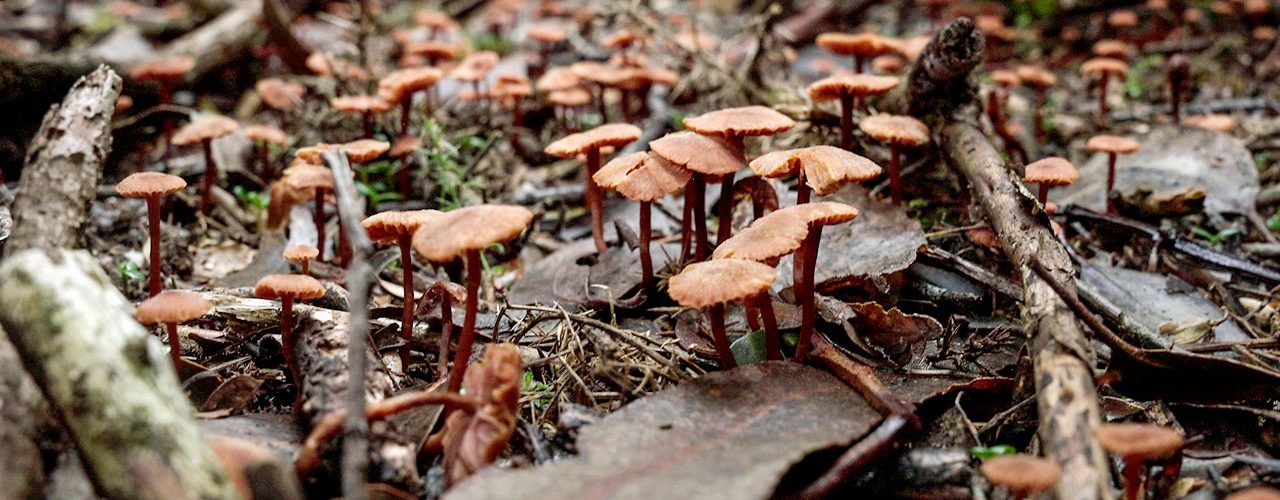Myconauts aim to reveal the often hidden soil fungi that shape ecosystems
CHILE’S VILLARRICA NATIONAL PARK—As a motley medley of mycologists climbed the basalt slopes of the Lanín volcano earlier this year, the green foliage at lower elevations gave way to autumnal golds and reds. Chile’s famed Araucaria—commonly called monkey puzzle trees—soon appeared, their spiny branches curving jauntily upward like so many cats’ tails.
智利维拉里卡国家公园—今年早些时候,真菌学家们混杂在一起爬上了拉宁火山的玄武岩斜坡,较低海拔的绿叶被秋天的金色和红色所取代。智利著名的南洋杉——通常被称为猴子拼图树,很快出现了,它们多刺的树枝欢快地向上弯曲,就像许多猫的尾巴一样。
Beneath the majestic trees, the scientists were focused on something far less glamorous—indeed, mostly invisible: mycorrhizal fungi, tiny organisms that intertwine with roots of the Araucaria and nearly all the other plants in this forest. The multinational research team had come to collect soil samples they hoped would, with help from DNA testing, reveal exactly which fungi live here, and how they support this complex assemblage of flora. By the end of an exhausting day that included bushwhacking through heavy brush, the fungi hunters had filled seven small plastic sacks with dirt from different locations. “I wouldn’t be surprised if there are 100 undescribed species” of fungi in each bag, said mycologist Giuliana Furci, founder of the Chilean nonprofit Fungi Foundation and one of the expedition leaders.
在这些雄伟的树木下,科学家们专注于一种远没有那么迷人、几乎看不见的东西:菌根真菌,一种与南洋杉根和这片森林中几乎所有其他植物交织在一起的微小生物。多国研究小组前来收集土壤样本,他们希望在DNA测试的帮助下,能够准确地揭示哪些真菌生活在这里,以及它们如何支持这种复杂的植物群。在一天疲惫的工作结束时,包括通过沉重的灌木丛进行灌木丛捕猎,真菌猎手已经用七个小塑料袋装满了来自不同地方的泥土。“如果每个袋子里有100种未描述的真菌,我不会感到惊讶,”真菌学家朱利亚娜·福奇说,她是智利非营利真菌基金会的创始人,也是探险队的领导者之一。
The April ascent was also a road test of sorts: the first of many surveys that the Society for the Protection of Underground Networks (SPUN), a new fungus-focused nonprofit, hopes to conduct. It has raised some $3.5 million for an ambitious effort to map the global distribution of mycorrhizal fungi, which can create subterranean networks that are thought to play a key, but often overlooked, role in shaping ecosystems.
四月的上坡也是一次路考:一个新的以真菌为重点的非营利组织——地下网络保护协会(SPUN)希望进行的许多调查中的第一次。它筹集了大约350万美元,用于绘制菌根真菌全球分布图的雄心勃勃的努力,这可以创建地下网络,人们认为地下网络在塑造生态系统方面发挥着关键作用,但往往被忽视。
“Up to 50% of the living biomass of soils are these networks,” says ecologist Toby Kiers of VU Amsterdam, a co-founder of SPUN and one of the leaders of the Chile expedition. “We have to figure out where they are and what they’re doing.”
“高达50%的土壤生物量是这些菌丝网,”VU Amsterdam的生态学家托比·基尔斯说,他是SPUN的联合创始人,也是智利探险队的领导者之一。“我们必须弄清楚他们在哪里,在做什么。”
SPUN’s approach is bold—even bombastic. The project launched last fall with a media-savvy campaign, including slick videos, arguing that society must do more to study and protect fungi to safeguard biodiversity and curb climate change. SPUN researchers describe themselves as “myconauts” heading into the unknown. They wear customized blue jumpsuits emblazoned with “PROTECT THE UNDERGROUND” for publicity photos and when working in the field. (“I really love jumpsuits,” Kiers says.) A documentary video crew followed SPUN scientists on their first expedition, into Chile. Celebrities such as primatologist Jane Goodall and best-selling author Michael Pollan have signed on as SPUN advisers.
SPUN的方法大胆甚至夸夸其谈。该项目是去年秋天发起的一场媒体攻势,包括流畅的视频,认为社会必须做更多的工作来研究和保护真菌,以保护生物多样性和遏制气候变化。研究人员将自己描述为走向未知的“真菌”。他们穿着印有“保护地下”字样的定制蓝色连体衣,拍摄宣传照片和在野外工作时穿着。(“我真的很喜欢连体衣,”基尔斯说。)一个纪录片摄制组跟随旋转科学家首次远征智利。灵长类动物学家简·古道尔和畅销书作家迈克尔·波伦等名人已签约担任顾问。
Some researchers, however, harbor doubts that SPUN’s mapping effort will have much practical impact, noting that conservationists are already protecting forests and other ecosystems that harbor fungi and store planet-warming carbon. Others question whether the surveys will appreciably add to what scientists already know, in part because SPUN is only studying one segment of the fungal community: those that form associations with plant roots.
然而,一些研究人员怀疑SPUN的绘图工作是否会产生多大的实际影响,并指出,自然资源保护主义者已经在保护森林和其他滋生真菌并储存全球变暖碳的生态系统。其他人质疑这些调查是否会明显增加科学家已经知道的内容,部分原因是SPUN只研究真菌群落的一部分:那些与植物根系形成联系的部分。
Mapping “a single class of microorganism seems to me too limited to come to an understanding of the big picture,” says Heribert Hirt, a plant scientist at the King Abdullah University of Science and Technology. “I am rather skeptical that we will really learn a lot from this big science project.”
阿卜杜拉国王科技大学(King Abdullah University of Science and Technology)的植物科学家赫里伯特·赫斯特说,绘制“一类微生物的图谱对我来说太有限了,无法理解全局。”“我相当怀疑我们是否真的能从这个大科学项目中学到很多东西。”
But SPUN’s effort to make soil fungi more visible is being welcomed by most mycologists, who often feel as overlooked as the organisms they study. “I don’t think anything like this has ever happened before,” says Kabir Peay, a mycologist at Stanford University who advises SPUN. “It’s amazing there are philanthropists that have the vision and interest to support this type of activity.”
但是,SPUN使土壤真菌更加明显的努力受到了大多数真菌学家的欢迎,他们经常感到自己和他们研究的生物体一样被忽视。斯坦福大学的真菌学家卡比尔·佩伊是SPUN的顾问,他说:“我认为以前从未发生过这样的事情。”。“令人惊讶的是,有慈善家有远见和兴趣支持这类活动。”
Read more at Science.org
在Science.org上阅读更多











